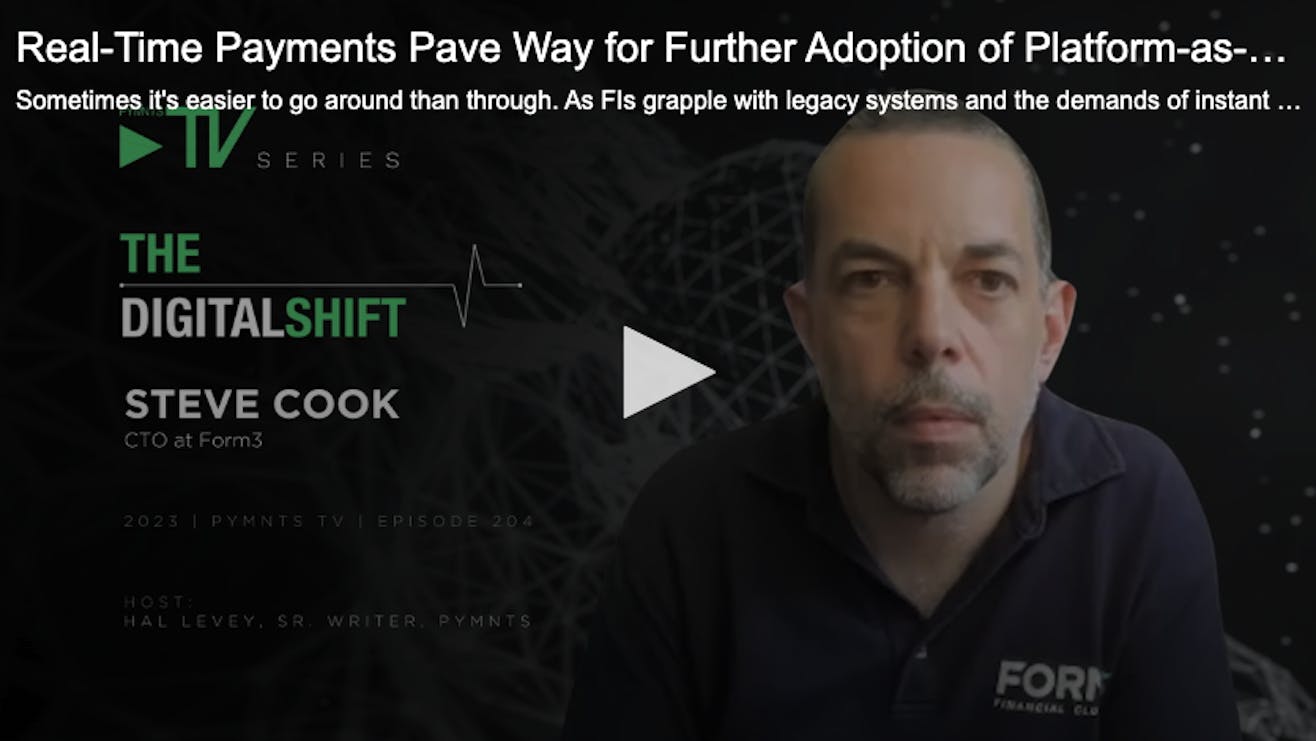Real-Time Payments Pave Way for Further Adoption of Platform-as-a-Service Models
Thought Leadership· 3min September 14, 2023
Steve Cook, Chief Technology Officer at Form3, said in an interview with PYMNTS that the Platform-as-a-Service model is seeing a tailwind from the rise of instant payments.
He noted that the United States may be in “a bit of a transformation at the moment,” as real-time payments grab headlines, and the FedNow® Service has debuted (and where The Clearing House’s RTP Network® has been around for six years).
But, he added, faster payments have been ramping up for several years in the United Kingdom and elsewhere. Form3, for its part, has been processing traffic on its platforms tied to instant payments for more than six years.

Faster payments, he said, “may be relatively new, but they’re not bleeding edge anymore.” The same goes for Platform-as-a-Service, where much of the technical heavy lifting of payments and new modalities is outsourced to providers (Form3 among them) which offer ease of connectivity without client firms having to rip and replace legacy systems.
While the early adopters may have been the digital challenger banks, the new entrants embracing Platform-as-a-Service now are the tier-one banks that have been grappling with the challenges and opportunities inherent in their own digital transformation.
“They’ve typically had a lot of complex legacy ‘estate,’” Cook said, with a lot of moving parts, and have found a keen desire to sidestep the complexities of the back office.
“They’re solving issues with their current [banking] platforms, as well as adopting instant payments,” he said.
With the Platform-as-a-Service model, he added, instant payments can sit alongside existing flows as financial institutions (FIs) migrate piece by piece onto a new technology stack without necessarily having to throw away a lot of what they already have in place. With application programming interfaces (APIs), connectivity can be fine-tuned on a
Rethinking Payments
“What we’ve seen typically with our customers as they’ve gone through a journey is they’ll start off with a subset of payments,” said Cook. “They might start off with retail customers doing instant payments, but then gradually move across to, say, corporate flows, which are more complicated.”
The shift toward instant payments is prompting banks to rethink their strategies across a range of payments — and route what might be thought of as more traditional payments, such as ACH, more efficiently as well.
“We can bring this all together,” said Cook, which is especially pressing given the fact that batch-file-based systems are no longer fit for purpose. Payments might be captured through online banking, phone, digital channels or apps but have very different flows through the back office. Giving enterprises a flexible platform that allows them to manage those flows effectively can help them prioritize what is important for customers and what is important for their business when it comes to payments.
Asked by PYMNTS what lies ahead, Cook said in the U.K., open banking gives a clue as to what’s next for Platform-as-a-Service model providers.
“It’s not just cards and cash,” he said, adding that “it’s actually about whether you can enable lots of different ways and lots of different services for end customers — whether that’s paying by installments or pay by bank … this offers flexibility to customers, and it also potentially offers big cost savings to the financial institutions because they’d be able to move things onto account-to-account rails that traditionally haven’t been there before.”
The eventuality is that we’re headed to a world where real-time payment schemes are interoperable, which will transform cross-border and B2B payments.
In that case, “we’re connecting a scheme to a platform model where everything can be shared” more easily, and “the data and the transactions are now all on the same platform … and that starts to enable some really interesting use cases such as fraud, AML, etc.,” he told PYMNTS.
Originally published on PYMNTS.com
Written by
Steve has architected and developed great products and managed dynamic technology teams in the financial services sector for over 30 years. He brings a broad range of experience in FinTech, having led key technology teams across banking (Lehman Brothers, Nomura, Gain Capital), and having launched several startups in the FinTech and cloud computing space.
Steve previously lived and worked in Asia for 15 years, and has extensive experience in the Asian banking and capital markets environment. He also holds a degree in theoretical physics from Cambridge University.
As the founding CTO at Form3, he was responsible for all aspects of technology, including product architecture, development, delivery and support of the platform. Now serving as a Strategic Advisor, Steve brings his extensive technical and industry knowledge to guide Form3’s long-term vision and innovation.









 Back to News
Back to News

